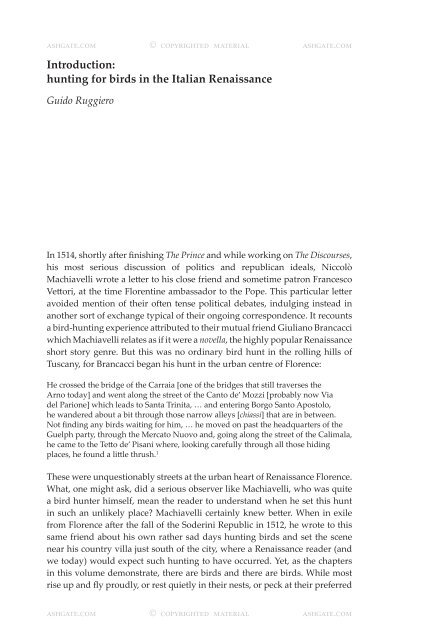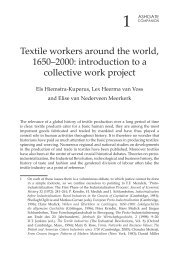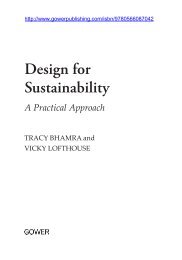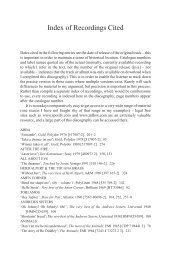Introduction: hunting for birds in the Italian Renaissance - Ashgate
Introduction: hunting for birds in the Italian Renaissance - Ashgate
Introduction: hunting for birds in the Italian Renaissance - Ashgate
Create successful ePaper yourself
Turn your PDF publications into a flip-book with our unique Google optimized e-Paper software.
ashgate.com © copyrighted material ashgate.com<br />
<strong>Introduction</strong>:<br />
<strong>hunt<strong>in</strong>g</strong> <strong>for</strong> <strong>birds</strong> <strong>in</strong> <strong>the</strong> <strong>Italian</strong> <strong>Renaissance</strong><br />
Guido Ruggiero<br />
In 1514, shortly after f<strong>in</strong>ish<strong>in</strong>g The Pr<strong>in</strong>ce and while work<strong>in</strong>g on The Discourses,<br />
his most serious discussion of politics and republican ideals, Niccolò<br />
Machiavelli wrote a letter to his close friend and sometime patron Francesco<br />
Vettori, at <strong>the</strong> time Florent<strong>in</strong>e ambassador to <strong>the</strong> Pope. This particular letter<br />
avoided mention of <strong>the</strong>ir often tense political debates, <strong>in</strong>dulg<strong>in</strong>g <strong>in</strong>stead <strong>in</strong><br />
ano<strong>the</strong>r sort of exchange typical of <strong>the</strong>ir ongo<strong>in</strong>g correspondence. It recounts<br />
a bird-<strong>hunt<strong>in</strong>g</strong> experience attributed to <strong>the</strong>ir mutual friend Giuliano Brancacci<br />
which Machiavelli relates as if it were a novella, <strong>the</strong> highly popular <strong>Renaissance</strong><br />
short story genre. But this was no ord<strong>in</strong>ary bird hunt <strong>in</strong> <strong>the</strong> roll<strong>in</strong>g hills of<br />
Tuscany, <strong>for</strong> Brancacci began his hunt <strong>in</strong> <strong>the</strong> urban centre of Florence:<br />
He crossed <strong>the</strong> bridge of <strong>the</strong> Carraia [one of <strong>the</strong> bridges that still traverses <strong>the</strong><br />
Arno today] and went along <strong>the</strong> street of <strong>the</strong> Canto de’ Mozzi [probably now Via<br />
del Parione] which leads to Santa Tr<strong>in</strong>ita, … and enter<strong>in</strong>g Borgo Santo Apostolo,<br />
he wandered about a bit through those narrow alleys [chiassi] that are <strong>in</strong> between.<br />
Not f<strong>in</strong>d<strong>in</strong>g any <strong>birds</strong> wait<strong>in</strong>g <strong>for</strong> him, … he moved on past <strong>the</strong> headquarters of <strong>the</strong><br />
Guelph party, through <strong>the</strong> Mercato Nuovo and, go<strong>in</strong>g along <strong>the</strong> street of <strong>the</strong> Calimala,<br />
he came to <strong>the</strong> Tetto de’ Pisani where, look<strong>in</strong>g carefully through all those hid<strong>in</strong>g<br />
places, he found a little thrush. 1<br />
These were unquestionably streets at <strong>the</strong> urban heart of <strong>Renaissance</strong> Florence.<br />
What, one might ask, did a serious observer like Machiavelli, who was quite<br />
a bird hunter himself, mean <strong>the</strong> reader to understand when he set this hunt<br />
<strong>in</strong> such an unlikely place? Machiavelli certa<strong>in</strong>ly knew better. When <strong>in</strong> exile<br />
from Florence after <strong>the</strong> fall of <strong>the</strong> Soder<strong>in</strong>i Republic <strong>in</strong> 1512, he wrote to this<br />
same friend about his own ra<strong>the</strong>r sad days <strong>hunt<strong>in</strong>g</strong> <strong>birds</strong> and set <strong>the</strong> scene<br />
near his country villa just south of <strong>the</strong> city, where a <strong>Renaissance</strong> reader (and<br />
we today) would expect such <strong>hunt<strong>in</strong>g</strong> to have occurred. Yet, as <strong>the</strong> chapters<br />
<strong>in</strong> this volume demonstrate, <strong>the</strong>re are <strong>birds</strong> and <strong>the</strong>re are <strong>birds</strong>. While most<br />
rise up and fly proudly, or rest quietly <strong>in</strong> <strong>the</strong>ir nests, or peck at <strong>the</strong>ir preferred<br />
ashgate.com © copyrighted material ashgate.com
erotic cultures of renaissance italy<br />
ashgate.com © copyrighted material ashgate.com<br />
foods <strong>in</strong> fields, courtyards and even occasionally at court, some do so more<br />
metaphorically than o<strong>the</strong>rs.<br />
The <strong>birds</strong> that Machiavelli humorously referred to were <strong>the</strong> same as those<br />
discussed by Allen Grieco <strong>in</strong> Chapter 3: ‘From Roosters to Cocks: <strong>Italian</strong><br />
<strong>Renaissance</strong> Food and Sexuality’. What is important about <strong>the</strong>se <strong>birds</strong> is <strong>the</strong>ir<br />
widely understood set of cultural implications. The ways <strong>in</strong> which a given<br />
society alludes to <strong>the</strong> erotic – such as <strong>the</strong> ris<strong>in</strong>g flight of a phallus, its quiet<br />
nest<strong>in</strong>g <strong>in</strong> a codpiece, its burrow<strong>in</strong>g <strong>in</strong>to a metaphorical and fem<strong>in</strong><strong>in</strong>e ‘nest’<br />
or its peck<strong>in</strong>g at a preferred ‘fig’ – implies a shared and codified vision of life,<br />
both material and imag<strong>in</strong>ary. Such widely-used metaphors provide a crucial<br />
w<strong>in</strong>dow onto <strong>the</strong> way daily life was lived, understood and imag<strong>in</strong>ed. They<br />
provide <strong>in</strong>sights <strong>in</strong>to an allusive manner of th<strong>in</strong>k<strong>in</strong>g and speak<strong>in</strong>g that was<br />
entirely transparent <strong>in</strong> <strong>the</strong> past, yet rema<strong>in</strong>s relatively obscure today. Although<br />
this coded convention was understood, used and implemented at all levels of<br />
society, it has tended to be marg<strong>in</strong>alized if not entirely neglected by scholars.<br />
It is <strong>the</strong> identification and translation of this shared code that constitutes <strong>the</strong><br />
premise of this book, and <strong>the</strong> motivation beh<strong>in</strong>d this collective <strong>in</strong>vestigation<br />
<strong>in</strong>to <strong>the</strong> erotic cultures of <strong>Renaissance</strong> Italy.<br />
To return to Machiavelli’s clever tale, any <strong>Renaissance</strong> reader who knew<br />
Florence well (as Vettori did) would have understood immediately from <strong>the</strong><br />
description of Brancacci’s <strong>hunt<strong>in</strong>g</strong> places which type of ‘bird’ he had gone to<br />
seek. Machiavelli moved his hunter through <strong>the</strong> heart of <strong>the</strong> city and <strong>in</strong>to <strong>the</strong><br />
centre of a district noted <strong>for</strong> prostitution and illicit sex of every sort, <strong>in</strong>clud<strong>in</strong>g<br />
male prostitution. In <strong>the</strong> end, however, <strong>the</strong> ‘little thrush’ that Brancacci found<br />
was no ord<strong>in</strong>ary ‘bird’ belong<strong>in</strong>g to a poor young man prostitut<strong>in</strong>g himself.<br />
This bird belonged <strong>in</strong>stead to <strong>the</strong> son of an important Florent<strong>in</strong>e official, a<br />
youth named Michele who, despite his political and social stand<strong>in</strong>g, <strong>in</strong>sisted<br />
on be<strong>in</strong>g paid <strong>for</strong> his services. When Brancacci tried to con <strong>the</strong> lad out of<br />
<strong>the</strong> money demanded by claim<strong>in</strong>g, <strong>in</strong> <strong>the</strong> dark, that he was someone else<br />
(a mutual friend of <strong>the</strong>irs well known <strong>for</strong> his <strong>in</strong>terest <strong>in</strong> teenage boys) and<br />
suggest<strong>in</strong>g that he could be trusted to pay him <strong>the</strong> next day, <strong>the</strong> story took on<br />
ano<strong>the</strong>r series of complications – enlivened with classical allusions to Ovid’s<br />
Metamorphoses – that we cannot follow here.<br />
The po<strong>in</strong>t is simply that, with Machiavelli’s letter, we are quickly drawn<br />
<strong>in</strong>to what appears to be a very different and unusual <strong>Italian</strong> <strong>Renaissance</strong>, a<br />
diverse cultural world or series of worlds revealed <strong>in</strong> <strong>the</strong> correspondence of<br />
one of <strong>the</strong> most famous figures of <strong>the</strong> age. But as this volume makes clear,<br />
this cultural world is not an entirely different or unusual <strong>Italian</strong> <strong>Renaissance</strong><br />
at all. As <strong>the</strong> chapters presented here demonstrate over and over aga<strong>in</strong>, it is<br />
no longer possible to ignore <strong>the</strong> generally shared culture of <strong>the</strong> erotic and its<br />
omnipresence <strong>in</strong> daily exchange, nor is it possible to overlook <strong>the</strong> particular<br />
subcultures that coexisted at <strong>the</strong> time and that were such a central part of<br />
daily life. To neglect any of <strong>the</strong>se aspects of <strong>Italian</strong> culture means that one<br />
will not see, read, hear nor ultimately understand <strong>the</strong> rich complexity of <strong>the</strong><br />
<strong>Renaissance</strong>. The friendship between Machiavelli and Vettori, <strong>the</strong> nightlife<br />
ashgate.com © copyrighted material ashgate.com
Guido Ruggiero<br />
ashgate.com © copyrighted material ashgate.com<br />
<strong>in</strong> <strong>the</strong> urban heart of Florence, <strong>the</strong> smell of flesh <strong>in</strong> <strong>the</strong> streets, <strong>the</strong> Medici<br />
build<strong>in</strong>gs rented to prostitutes and bath houses, all <strong>the</strong>se are key elements <strong>in</strong><br />
<strong>the</strong> tale of Michele, <strong>the</strong> young son of an important Florent<strong>in</strong>e official, lurk<strong>in</strong>g <strong>in</strong><br />
a dark corner and demand<strong>in</strong>g to be paid <strong>for</strong> his services. These obscure corners<br />
at <strong>the</strong> heart of <strong>the</strong> vibrant life of <strong>the</strong> city, even <strong>the</strong> urban <strong>hunt<strong>in</strong>g</strong> of <strong>birds</strong>,<br />
require a deeper and more complex understand<strong>in</strong>g of <strong>the</strong> sexual environment<br />
of <strong>the</strong> <strong>Renaissance</strong> world, an understand<strong>in</strong>g to which this collection makes a<br />
series of important contributions.<br />
Machiavelli’s letter transmits an aspect of <strong>Renaissance</strong> culture and <strong>the</strong><br />
cultures of <strong>the</strong> erotic that is a central and important <strong>the</strong>me of this volume.<br />
At one level, it evokes a widely shared frame of reference <strong>in</strong> which virtually<br />
everyone, from <strong>the</strong> humblest peasant to <strong>the</strong> most ref<strong>in</strong>ed humanist or patron<br />
of art knew, understood and could appreciate that a bird was not simply<br />
a bird. This common culture associated a rich nexus of emotions, deeds,<br />
imag<strong>in</strong><strong>in</strong>gs and everyday practices with <strong>the</strong> erotic, and expressed <strong>the</strong>se<br />
associations <strong>in</strong> ways often specific to <strong>the</strong> period. With<strong>in</strong> this shared frame of<br />
reference, <strong>the</strong>re were also areas <strong>in</strong> which <strong>the</strong> erotic was adapted and played<br />
with <strong>in</strong> ways suited to particular social groups, genres of art or literature and<br />
particular places or spaces. This diversity demonstrates that – over and above<br />
<strong>the</strong> common, shared culture that spanned all levels of <strong>Renaissance</strong> society –<br />
<strong>the</strong>re were also variant erotic cultures specific to subgroups or to precise<br />
locations.<br />
As a result of this complexity, <strong>the</strong> bird-<strong>hunt<strong>in</strong>g</strong> allusions of Machiavelli’s<br />
letter would have been understood immediately by most readers or listeners<br />
while <strong>the</strong> specific references to <strong>the</strong> places of male prostitution <strong>in</strong> Florence, or<br />
his classical references to Ovid, would have required more specific knowledge.<br />
For <strong>the</strong> <strong>for</strong>mer, a familiarity with <strong>the</strong> sexual topography of <strong>the</strong> city and its illicit<br />
world would have been necessary, while <strong>the</strong> latter required an acqua<strong>in</strong>tance<br />
with <strong>the</strong> erotic literature of ancient Rome. In terms of <strong>the</strong> cultural levels of<br />
participants <strong>in</strong> <strong>Renaissance</strong> exchanges and sexual <strong>in</strong>nuendo, it is significant<br />
that a number of <strong>the</strong> chapters <strong>in</strong> this volume, all of which share <strong>the</strong> premise of<br />
a common erotic culture, also call <strong>in</strong>to question <strong>the</strong> traditional ‘trickle down’<br />
vision of <strong>Renaissance</strong> culture that sees it as descend<strong>in</strong>g from <strong>the</strong> <strong>in</strong>tellectual<br />
elite through <strong>the</strong> various social classes to <strong>the</strong> rest of society. Thus many of<br />
<strong>the</strong> chapters, faithful to <strong>the</strong> precepts of <strong>the</strong> ‘new’ cultural history, posit a<br />
more circular exchange and demonstrate how artefacts, images and practices<br />
frequently moved up <strong>the</strong> social scale, with fasc<strong>in</strong>at<strong>in</strong>g concrete examples. 2<br />
S<strong>in</strong>ce <strong>the</strong> 1980s, <strong>in</strong> fact, a number of <strong>Renaissance</strong> scholars have begun to<br />
explore <strong>the</strong> circulation of culture <strong>in</strong> <strong>the</strong> <strong>Renaissance</strong>, <strong>in</strong> <strong>the</strong> area of <strong>the</strong> erotic<br />
as well as <strong>in</strong> o<strong>the</strong>r areas of cultural production. But, like Brancacci on his bird<strong>hunt<strong>in</strong>g</strong><br />
adventure, today’s historians, art historians, music historians and<br />
literary scholars who set out to <strong>in</strong>vestigate <strong>the</strong> erotic cultures of <strong>the</strong> <strong>Italian</strong><br />
<strong>Renaissance</strong> have had to leave beh<strong>in</strong>d <strong>the</strong> places where <strong>the</strong>y used to hunt<br />
<strong>for</strong> <strong>the</strong>ir material and f<strong>in</strong>d o<strong>the</strong>r places <strong>in</strong> which <strong>the</strong> past is hidden: at times<br />
<strong>the</strong> dark corners <strong>in</strong> <strong>the</strong> familiar streets of history, at times uncultivated or<br />
ashgate.com © copyrighted material ashgate.com
erotic cultures of renaissance italy<br />
ashgate.com © copyrighted material ashgate.com<br />
virtually unexplored territories. And to cont<strong>in</strong>ue <strong>the</strong> metaphor, historians have<br />
also developed new methods of <strong>hunt<strong>in</strong>g</strong> and have looked to o<strong>the</strong>r discipl<strong>in</strong>es<br />
<strong>for</strong> more fruitful techniques. Over <strong>the</strong> last generation, this has led to a literal<br />
explosion of scholarship on <strong>the</strong> body, sex and <strong>the</strong> erotic <strong>in</strong> <strong>the</strong> <strong>Italian</strong> <strong>Renaissance</strong><br />
as well as <strong>in</strong> o<strong>the</strong>r areas. In this context, this volume is particularly significant<br />
because it suggests how much excit<strong>in</strong>g and important <strong>hunt<strong>in</strong>g</strong> still rema<strong>in</strong>s to<br />
be done. In fact, virtually every chapter here might serve as a prolegomenon to<br />
future studies: <strong>the</strong> first half of <strong>the</strong> volume opens new vistas on material culture<br />
and artistic production more broadly def<strong>in</strong>ed, while <strong>the</strong> second half reth<strong>in</strong>ks<br />
<strong>the</strong> social and ritual deployment of <strong>the</strong> erotic with a reveal<strong>in</strong>g emphasis on<br />
everyday practice over prescriptive <strong>the</strong>ory. At <strong>the</strong> same time, each of <strong>the</strong> chapters<br />
demonstrates how our traditional understand<strong>in</strong>g of <strong>Italian</strong> <strong>Renaissance</strong> culture<br />
and society will be significantly enriched by more aggressively <strong>hunt<strong>in</strong>g</strong> <strong>the</strong><br />
<strong>birds</strong> and <strong>the</strong> erotic culture of this period.<br />
This volume has its orig<strong>in</strong> <strong>in</strong> a selection of papers on <strong>the</strong> erotic cultures<br />
of <strong>the</strong> <strong>Italian</strong> <strong>Renaissance</strong> presented <strong>in</strong> panels organized by Sara Mat<strong>the</strong>ws-<br />
Grieco <strong>for</strong> <strong>the</strong> <strong>Renaissance</strong> Society of America annual meet<strong>in</strong>g held <strong>in</strong><br />
Cambridge, England <strong>in</strong> 2005. Part I of this book, ‘Visual testimony and verbal<br />
games’, focuses on iconographic conventions, material culture and cultural<br />
production. It opens with a chapter by Mat<strong>the</strong>ws-Grieco herself, evocatively<br />
titled ‘Satyrs and sausages: erotic strategies and <strong>the</strong> pr<strong>in</strong>t market <strong>in</strong> C<strong>in</strong>quecento<br />
Italy’. Here an historian with a special eye <strong>for</strong> art looks at <strong>the</strong> sixteenthcentury<br />
market <strong>for</strong> pr<strong>in</strong>ts, demonstrat<strong>in</strong>g how <strong>the</strong> technical <strong>in</strong>novation of <strong>the</strong><br />
mechanical reproduction of images created new possibilities <strong>for</strong> erotic images<br />
that were quickly exploited at all levels of <strong>the</strong> pr<strong>in</strong>t market. Most notably, she<br />
identifies a broad cultural divide <strong>in</strong> <strong>the</strong> mak<strong>in</strong>g and market<strong>in</strong>g of erotic pr<strong>in</strong>ts,<br />
dist<strong>in</strong>guish<strong>in</strong>g between images aimed at an upscale elite market and pr<strong>in</strong>ts<br />
produced <strong>for</strong> a more general public. Un<strong>for</strong>tunately, few examples of pr<strong>in</strong>ts<br />
survive <strong>for</strong> ei<strong>the</strong>r market: upscale images have suffered at <strong>the</strong> hands of later<br />
censors and generations of heirs more prudish than <strong>the</strong>ir orig<strong>in</strong>al collectors,<br />
while <strong>the</strong> cheaper, often less artistic and lower quality pictures that were<br />
created <strong>for</strong> a more general public have had an even more limited survival<br />
rate.<br />
Never<strong>the</strong>less, work<strong>in</strong>g with <strong>the</strong> limited body of images that are still<br />
available today, Mat<strong>the</strong>ws-Grieco shows how engravers and pr<strong>in</strong>t publishers<br />
often created multiple versions of <strong>the</strong> same pr<strong>in</strong>t. It seems to have been<br />
fairly common practice <strong>for</strong> a pr<strong>in</strong>tmaker to make an erotically explicit or<br />
‘pornographic’ image targeted at a limited circle of elite buyers, a niche market<br />
that presumably appreciated such frankness (such as <strong>the</strong> circle of friends<br />
with whom Machiavelli shared his more suggestive letters). Subsequently,<br />
a less explicit and more erotically allusive version of <strong>the</strong> same engrav<strong>in</strong>g<br />
was reworked on <strong>the</strong> same plate and pr<strong>in</strong>ted <strong>for</strong> a larger, presumably less<br />
tolerant market that would have been more subject to censorship. In <strong>the</strong><br />
context of this discussion, Mat<strong>the</strong>ws-Grieco makes a useful dist<strong>in</strong>ction<br />
between erotic and pornographic images that works well both <strong>for</strong> <strong>the</strong> volume<br />
ashgate.com © copyrighted material ashgate.com
Guido Ruggiero<br />
ashgate.com © copyrighted material ashgate.com<br />
as a whole and <strong>for</strong> <strong>the</strong> <strong>Renaissance</strong> <strong>in</strong> general. This dist<strong>in</strong>ction is def<strong>in</strong>ed by<br />
what <strong>the</strong> author terms ‘<strong>the</strong> decency threshold’ of <strong>the</strong> period, whereby <strong>the</strong><br />
pornographic is taken <strong>in</strong> its orig<strong>in</strong>al Greek sense as that which represents <strong>the</strong><br />
act of phallic penetration, while <strong>the</strong> erotic represents <strong>the</strong> human body <strong>in</strong> more<br />
evocative and sexually suggestive ways. She demonstrates how <strong>the</strong> various<br />
elaborations of pr<strong>in</strong>ts move from <strong>the</strong> <strong>for</strong>mer to <strong>the</strong> latter as <strong>the</strong>y are aimed<br />
at broader markets. Of course, as this author notes, <strong>the</strong> decency threshold<br />
was not always respected by <strong>the</strong> <strong>Italian</strong> art market, and <strong>the</strong>re are areas of<br />
overlap or even direct transpositions from one side to <strong>the</strong> o<strong>the</strong>r. When crudely<br />
displayed or not camouflaged with a classical sett<strong>in</strong>g, <strong>the</strong> representation of<br />
female genitalia or <strong>the</strong> male erect phallus could be perceived as transgress<strong>in</strong>g<br />
visual conventions and approach<strong>in</strong>g <strong>the</strong> scandalously obscene. Simply stated,<br />
boundaries <strong>in</strong> <strong>the</strong> area of <strong>the</strong> erotic rema<strong>in</strong>ed plural, def<strong>in</strong>ed by time period,<br />
place of production, display, artistic style, humanist packag<strong>in</strong>g, social and<br />
<strong>in</strong>tellectual milieu, <strong>the</strong> consumer, <strong>the</strong> censor and <strong>the</strong> age or <strong>the</strong> gender of<br />
<strong>the</strong> viewer. Then as now, <strong>the</strong>re was room <strong>for</strong> considerable ambiguity <strong>in</strong> such<br />
attempts at def<strong>in</strong><strong>in</strong>g where divisions should lie.<br />
To make erotic representations <strong>for</strong> <strong>the</strong> elite less troubl<strong>in</strong>g and to give <strong>the</strong>m a<br />
suitably educated tone, pr<strong>in</strong>tmakers adopted <strong>the</strong>mes from Classical Antiquity,<br />
such as <strong>the</strong> Amori degli dei (Loves of <strong>the</strong> Gods), which allowed <strong>the</strong>m to represent<br />
naked bodies <strong>in</strong> suggestive poses with a veneer of <strong>in</strong>tellectual respectability.<br />
In a pagan context (pre-Christian and thus pre-Orig<strong>in</strong>al S<strong>in</strong>), nudity, eroticism<br />
and even to a degree <strong>the</strong> sexual act itself became less troublesome and somehow<br />
more erudite – humanism made even lust an <strong>in</strong>tellectual exercise. But as one<br />
moved down <strong>the</strong> social scale to pr<strong>in</strong>ts designed <strong>for</strong> a wider audience, classical<br />
mythology functioned less well with a clientele presumably less well versed<br />
<strong>in</strong> humanist culture. At this level, two o<strong>the</strong>r genres predom<strong>in</strong>ated <strong>in</strong> erotic<br />
pr<strong>in</strong>ts: <strong>the</strong> morality pr<strong>in</strong>t featur<strong>in</strong>g s<strong>in</strong>ners and <strong>the</strong> fallen <strong>in</strong> various stages<br />
of undress and potentially s<strong>in</strong>ful acts, and <strong>the</strong> humorous pr<strong>in</strong>t that played<br />
with metaphors such as bird <strong>hunt<strong>in</strong>g</strong> (aga<strong>in</strong>), cats and mice (woman’s genitals<br />
that caught and consumed male ones) or simply sausages. The satyr was a<br />
particularly useful icon <strong>in</strong> morality pr<strong>in</strong>ts as it allowed representations of<br />
<strong>the</strong> erect phallus (not human, but animal as <strong>the</strong> lower half of <strong>the</strong> satyr was<br />
animal) while develop<strong>in</strong>g a moral metaphor based on <strong>the</strong> need <strong>for</strong> man to<br />
control his lower, animal impulses by means of his reason (as represented<br />
by <strong>the</strong> human, upper half of <strong>the</strong> satyr). In conclusion, Mat<strong>the</strong>ws-Grieco<br />
emphasizes <strong>the</strong> wide circulation of <strong>the</strong>se pr<strong>in</strong>ts and <strong>the</strong>ir erotic metaphors <strong>in</strong><br />
<strong>the</strong> <strong>Renaissance</strong> world – a po<strong>in</strong>t re<strong>in</strong><strong>for</strong>ced by o<strong>the</strong>r chapters <strong>in</strong> this volume –<br />
and argues that art historians need to compile a dictionary of <strong>the</strong>se visual<br />
metaphors along <strong>the</strong> l<strong>in</strong>es of recent dictionaries of erotic euphemisms used <strong>in</strong><br />
<strong>the</strong> literature of <strong>the</strong> period. A dictionary of erotic art would permit scholars<br />
to understand <strong>the</strong> broad rang<strong>in</strong>g import of sexually connoted imagery <strong>in</strong> <strong>the</strong><br />
<strong>Italian</strong> <strong>Renaissance</strong> and <strong>the</strong> importance of its metaphorical use <strong>in</strong> contexts that<br />
ranged from <strong>the</strong> domestic household to political propaganda and religious<br />
<strong>in</strong>vective.<br />
ashgate.com © copyrighted material ashgate.com
erotic cultures of renaissance italy<br />
ashgate.com © copyrighted material ashgate.com<br />
If Mat<strong>the</strong>ws-Grieco extends <strong>the</strong> range of more traditional art history by<br />
look<strong>in</strong>g closely at <strong>the</strong> mean<strong>in</strong>gs and markets <strong>for</strong> erotic pr<strong>in</strong>ts, <strong>the</strong> next chapter<br />
by Guido Guerzoni, ‘The erotic fantasies of a model clerk’, takes us even far<strong>the</strong>r<br />
afield <strong>in</strong>to <strong>the</strong> virtually untouched realm of erotic and pornographic sketches<br />
done by ‘amateurs’ <strong>in</strong> <strong>the</strong> marg<strong>in</strong>s of <strong>Renaissance</strong> manuscripts. Pursu<strong>in</strong>g a<br />
serendipitous discovery of a series of draw<strong>in</strong>gs <strong>in</strong> early sixteenth-century<br />
Modenese account ledgers, apparently done by a scribe tentatively identified<br />
as Pietro Bertaldo (o<strong>the</strong>rwise largely unknown to history), Guerzoni delves<br />
deeper <strong>in</strong>to non-elite ways of represent<strong>in</strong>g and visually imag<strong>in</strong><strong>in</strong>g sex and <strong>the</strong><br />
body. In <strong>the</strong> footsteps of Carlo Poni and Carlo G<strong>in</strong>zburg, this chapter provides<br />
an example of a visual version of ‘<strong>the</strong> name is <strong>the</strong> game’ type of microhistory,<br />
as it was first <strong>the</strong>orized <strong>in</strong> <strong>the</strong> cutt<strong>in</strong>g-edge journal Quaderni storici almost a<br />
generation ago. 3 In this chapter, <strong>the</strong> author returns to <strong>the</strong> archives and uses<br />
similar techniques to tease deeper mean<strong>in</strong>g out of erotic sketches and doodles.<br />
Search<strong>in</strong>g <strong>in</strong> various manuscripts <strong>for</strong> similar survivals of a largely personal<br />
and private <strong>for</strong>m of erotic art at a ‘popular’ level, Guerzoni suggests that such<br />
work gives <strong>the</strong> lie to those who posit a trickle-down <strong>the</strong>ory of erotic culture.<br />
He argues persuasively that such draw<strong>in</strong>gs reflect a more generally shared<br />
culture of <strong>the</strong> erotic that may, <strong>in</strong> fact, have had a significant <strong>in</strong>fluence on more<br />
elite and ‘sophisticated’ artistic images, an example of culture mov<strong>in</strong>g up <strong>the</strong><br />
social scale ra<strong>the</strong>r than down. Like Mat<strong>the</strong>ws-Grieco, he calls <strong>for</strong> a scholarly<br />
project to catalogue <strong>the</strong>se images <strong>in</strong> order to provide a more systematic<br />
understand<strong>in</strong>g of <strong>the</strong>ir range and import.<br />
Focus<strong>in</strong>g primarily on what he sees as <strong>the</strong> pornographic, Guerzoni outl<strong>in</strong>es<br />
four areas of ‘amateur’ pornography worthy of fur<strong>the</strong>r study: <strong>the</strong> erotic created<br />
<strong>for</strong> personal reasons, found <strong>in</strong> manuscripts and o<strong>the</strong>r unrelated archival<br />
documents (largely <strong>the</strong> focus of <strong>the</strong> present study); ‘gallant’ manuscripts,<br />
where amateur erotic draw<strong>in</strong>gs were appended to letters or manuscripts meant<br />
to be shared with o<strong>the</strong>rs; hidden and not-so-hidden images that were often<br />
blasphemous and <strong>in</strong>sult<strong>in</strong>g to authority and, f<strong>in</strong>ally, obscene images that that<br />
were more ‘public’ as <strong>the</strong>y often accompanied pasqu<strong>in</strong>ades and defamatory<br />
pamphlet literature. This chapter also provides a f<strong>in</strong>e overview of <strong>the</strong> issues<br />
<strong>in</strong>volved <strong>in</strong> <strong>the</strong> preservation and survival of erotic and pornographic images<br />
which complements and extends Mat<strong>the</strong>ws-Grieco’s earlier discussion of <strong>the</strong><br />
issue <strong>for</strong> <strong>Renaissance</strong> pr<strong>in</strong>ts. But what is undoubtedly most <strong>in</strong>terest<strong>in</strong>g and<br />
<strong>in</strong>novative is Guerzoni’s discovery – and open<strong>in</strong>g <strong>for</strong> fur<strong>the</strong>r scholarly study –<br />
of a hi<strong>the</strong>rto neglected and largely unknown range of visual images hidden<br />
<strong>in</strong> <strong>Renaissance</strong> (as opposed to medieval) manuscripts, and above all <strong>in</strong> <strong>the</strong><br />
b<strong>in</strong>d<strong>in</strong>gs of archival material. This new material has <strong>the</strong> potential to be an<br />
important source <strong>for</strong> understand<strong>in</strong>g <strong>the</strong> shared erotic culture of <strong>Renaissance</strong><br />
Italy, a culture that hi<strong>the</strong>rto has been largely lost to history <strong>in</strong> that it falls below<br />
<strong>the</strong> level of <strong>the</strong> more easily accessible, aes<strong>the</strong>tically recognized and often elite<br />
artistic production of <strong>the</strong> period.<br />
Chapter 3 by Allen Grieco, ‘From roosters to cocks: <strong>Italian</strong> <strong>Renaissance</strong><br />
fowl and sexuality’, turns <strong>the</strong> discussion to <strong>birds</strong>. Here <strong>the</strong> author<br />
ashgate.com © copyrighted material ashgate.com
Guido Ruggiero<br />
ashgate.com © copyrighted material ashgate.com<br />
ventures well beyond ornithological lore and metaphor <strong>in</strong>to <strong>the</strong> rich realm<br />
of <strong>the</strong> association of food and sex, two pleasures of <strong>the</strong> body that <strong>in</strong> many<br />
cultures have generated a rich and reveal<strong>in</strong>g set of ways of th<strong>in</strong>k<strong>in</strong>g about<br />
(and express<strong>in</strong>g) physical desire and pleasure. The chapter beg<strong>in</strong>s with a<br />
discussion of <strong>the</strong> etymological and literary tradition of bird texts that provides<br />
a fasc<strong>in</strong>at<strong>in</strong>g history of avian allusions that range from nest<strong>in</strong>g to <strong>hunt<strong>in</strong>g</strong> to<br />
peck<strong>in</strong>g at figs. The essay <strong>the</strong>n exam<strong>in</strong>es <strong>the</strong> visual use of <strong>birds</strong> with a more or<br />
less explicit sexual mean<strong>in</strong>g appear<strong>in</strong>g at all levels of iconographic expression:<br />
graffiti on university benches, decorated pharmacy jars, obscene engrav<strong>in</strong>gs,<br />
morality pr<strong>in</strong>ts and even high art. He argues persuasively <strong>for</strong> <strong>the</strong> ubiquitous<br />
nature of <strong>the</strong> ornithological euphemism <strong>in</strong> <strong>Renaissance</strong> Italy, ‘not only as a<br />
metaphor <strong>for</strong> <strong>the</strong> male organ but also <strong>for</strong> <strong>the</strong> sexual act and <strong>the</strong> whole sphere<br />
of sexuality <strong>in</strong> general’, 4 and <strong>the</strong>n asks <strong>the</strong> logical question that has not yet<br />
found a satisfactory answer: what is <strong>the</strong> orig<strong>in</strong> of this association, and why is<br />
it so universal <strong>in</strong> this period?<br />
To resolve this fundamental problem, Grieco turns to <strong>the</strong> important dietary<br />
literature of <strong>the</strong> <strong>Renaissance</strong> (which he has extensively discussed <strong>in</strong> a number<br />
of earlier publications), and exam<strong>in</strong>es <strong>the</strong> place of <strong>birds</strong> as well as <strong>the</strong>ir erotic<br />
mean<strong>in</strong>gs <strong>in</strong> that area of literary production. Key to his read<strong>in</strong>g of alimentary<br />
lore are <strong>the</strong> classical ‘Great Cha<strong>in</strong> of Be<strong>in</strong>g’ and <strong>the</strong> humoral <strong>the</strong>ories current<br />
among <strong>the</strong> medical and dietary <strong>the</strong>orists of <strong>the</strong> day. Because <strong>birds</strong> were<br />
situated higher on <strong>the</strong> Great Cha<strong>in</strong> of Be<strong>in</strong>g, <strong>the</strong>y were considered a suitable<br />
food <strong>for</strong> <strong>the</strong> social elite and quite unsuitable <strong>for</strong> <strong>the</strong>ir social <strong>in</strong>feriors. The<br />
reason<strong>in</strong>g beh<strong>in</strong>d this lay <strong>in</strong> <strong>the</strong> fact that <strong>birds</strong> were creatures of <strong>the</strong> air and<br />
thus a type of food far superior to <strong>the</strong> base and earthly fare deemed appropriate<br />
<strong>for</strong> <strong>the</strong> lower classes (lowly foods like onions and garlic). Moreover, from<br />
<strong>the</strong> perspective of <strong>the</strong> humoral <strong>the</strong>ories of medical and dietary writers such<br />
as Michele Savonarola and Baldassarre Pisanelli, <strong>birds</strong> were hot and moist,<br />
humoral qualities associated with mascul<strong>in</strong>e sexuality and active, aggressive<br />
per<strong>for</strong>mance. As a result – and as moralists and preachers of <strong>the</strong> day warned –<br />
one could easily slide from <strong>the</strong> s<strong>in</strong> of gluttony (due to <strong>the</strong> consumption of<br />
fowl) <strong>in</strong>to <strong>the</strong> s<strong>in</strong> of lust (due to <strong>the</strong> physical consequences of eat<strong>in</strong>g such fare).<br />
Tell<strong>in</strong>gly, Grieco notes that only <strong>the</strong> ‘best’ of men were considered capable of<br />
controll<strong>in</strong>g <strong>the</strong> effects of eat<strong>in</strong>g <strong>birds</strong>, <strong>for</strong> <strong>the</strong>ir superiority meant that <strong>the</strong>y<br />
would be empowered, as opposed to corrupted, by such a potent foodstuff. In a<br />
ra<strong>the</strong>r amus<strong>in</strong>g example, he po<strong>in</strong>ts out <strong>the</strong> vast quantities of partridges served<br />
to <strong>the</strong> n<strong>in</strong>e Priors of Florence and <strong>the</strong>ir eventual d<strong>in</strong>ner guests: on an average,<br />
more than 65 <strong>birds</strong> were served per day. This particular item on <strong>the</strong> Priors’ menu<br />
was supposed to both re<strong>in</strong><strong>for</strong>ce <strong>the</strong>ir role as physically potent and politically<br />
aggressive leaders (<strong>in</strong> accordance with humoral <strong>the</strong>ory), and confirm <strong>the</strong>ir elite,<br />
social and political position (<strong>in</strong> terms of <strong>the</strong> Great Cha<strong>in</strong> of Be<strong>in</strong>g). Once aga<strong>in</strong>,<br />
a bird was not simply a bird; food and its culture were deeply <strong>in</strong>tertw<strong>in</strong>ed<br />
with<strong>in</strong> a widely shared erotic culture. In this erudite chapter, Grieco marshals<br />
religious, dietary, visual and literary evidence to demonstrate <strong>the</strong> penetration of<br />
<strong>the</strong>se cultural concepts at all levels of <strong>Renaissance</strong> society.<br />
ashgate.com © copyrighted material ashgate.com
erotic cultures of renaissance italy<br />
ashgate.com © copyrighted material ashgate.com<br />
The world of food and its social and sexual implications are just <strong>the</strong> tip<br />
of <strong>the</strong> iceberg <strong>in</strong> <strong>the</strong> dynamic between <strong>the</strong> everyday world and <strong>Renaissance</strong><br />
erotic cultures. In an article based on archival and literary texts published<br />
<strong>in</strong> <strong>the</strong> early 1990s, I called <strong>for</strong> a reread<strong>in</strong>g of <strong>Renaissance</strong> discourses about<br />
marriage, civic morality and <strong>the</strong> discipl<strong>in</strong><strong>in</strong>g of <strong>the</strong> body which would meld<br />
<strong>the</strong> methodological <strong>in</strong>novations of recent literary criticism with new trends<br />
<strong>in</strong> social and cultural history. 5 Crucial <strong>for</strong> such a reread<strong>in</strong>g, I argued, was <strong>the</strong><br />
way <strong>in</strong> which prescriptive literature and <strong>the</strong> leaders of society (at least <strong>in</strong> <strong>the</strong>ir<br />
capacity as leaders) <strong>in</strong>creas<strong>in</strong>gly perceived <strong>the</strong> culture of <strong>the</strong> ‘illicit’ as be<strong>in</strong>g a<br />
radical rejection of <strong>the</strong> central values of ‘licit’ society. What made this cultural<br />
tension particularly <strong>in</strong>terest<strong>in</strong>g was <strong>the</strong> degree to which <strong>the</strong>se two cultures<br />
were none<strong>the</strong>less deeply <strong>in</strong>tertw<strong>in</strong>ed, <strong>the</strong> way <strong>in</strong> which <strong>the</strong> boundaries of eros<br />
(between <strong>the</strong> licit and <strong>the</strong> illicit) were plural and highly porous. I suggested<br />
that those boundaries would be progressively hardened and <strong>the</strong> licit more<br />
clearly separated from <strong>the</strong> illicit, not just <strong>in</strong> prescriptive literature, sermons and<br />
legislation (as was <strong>the</strong> case <strong>in</strong> <strong>the</strong> <strong>Renaissance</strong>) but eventually also <strong>in</strong> practice,<br />
daily life and even our sense of self, which is perhaps one of <strong>the</strong> unrecognized<br />
keys that most separates <strong>the</strong> modern from <strong>the</strong> premodern. In Chapter 4, ‘“The<br />
spirit is ready, but <strong>the</strong> flesh is tired”: erotic objects and marriage <strong>in</strong> early<br />
modern Italy’, Marta Ajmar-Wollheim takes <strong>the</strong>se prelim<strong>in</strong>ary hypo<strong>the</strong>ses far<br />
beyond what I had imag<strong>in</strong>ed <strong>in</strong> that orig<strong>in</strong>al essay. Here she exam<strong>in</strong>es <strong>the</strong> rich<br />
mixture and deliberate overlap of <strong>the</strong> illicit and <strong>the</strong> licit that was to be found<br />
<strong>in</strong> <strong>the</strong> erotic culture of material objects surround<strong>in</strong>g marriage and everyday<br />
life <strong>in</strong> <strong>the</strong> <strong>Italian</strong> <strong>Renaissance</strong>.<br />
What Ajmar-Wollheim discovers is a porous set of boundaries where<br />
marriage, <strong>the</strong> most licit <strong>in</strong>stitutional sett<strong>in</strong>g <strong>for</strong> sex accord<strong>in</strong>g to <strong>the</strong><br />
prescriptive literature of <strong>the</strong> age, was rife with erotic material objects that,<br />
from a <strong>for</strong>mal po<strong>in</strong>t of view (<strong>in</strong> that <strong>the</strong>y represented frontal nudity and<br />
physical <strong>in</strong>timacy), belonged to <strong>the</strong> illicit. Yet, <strong>in</strong> <strong>the</strong> <strong>Renaissance</strong> household,<br />
<strong>the</strong> sexual was deeply <strong>in</strong>tertw<strong>in</strong>ed with <strong>the</strong> everyday. Pottery, <strong>for</strong> example,<br />
was often designed <strong>for</strong> domestic use (with a close etymological relationship<br />
to <strong>the</strong> contemporary obscene term <strong>for</strong> a woman’s genitals, pota) and, <strong>in</strong> many<br />
cases, its decoration provides an excellent example of this mix<strong>in</strong>g of <strong>the</strong><br />
erotic with <strong>the</strong> quotidian, <strong>the</strong> illicit with <strong>the</strong> licit, <strong>in</strong> a surpris<strong>in</strong>g number of<br />
surviv<strong>in</strong>g pieces that portray relatively explicit erotic scenes. As <strong>the</strong> author<br />
po<strong>in</strong>ts out, some of <strong>the</strong>se were drawn from <strong>the</strong> pr<strong>in</strong>t tradition discussed by<br />
Mat<strong>the</strong>ws-Grieco, but many were also based on Antique pottery rema<strong>in</strong>s<br />
discovered <strong>in</strong> <strong>the</strong> <strong>Renaissance</strong>. Ajmar-Wollheim suggests an important<br />
change over time <strong>in</strong> marriage-related maiolica between <strong>the</strong> beg<strong>in</strong>n<strong>in</strong>g of <strong>the</strong><br />
sixteenth century and <strong>the</strong> 1530s and 1540s, <strong>the</strong> latter reveal<strong>in</strong>g a dramatic shift<br />
<strong>in</strong> <strong>the</strong> representation of marital love ‘from <strong>for</strong>mal and symbolic compositions<br />
to more naturalistic, physically <strong>in</strong>timate and erotically charged scenes’. 6<br />
She sees this change as reflective of a desire to commemorate a marriage<br />
and its <strong>in</strong>ception by stress<strong>in</strong>g <strong>the</strong> sexual effusions and ritual <strong>in</strong>timacy that<br />
were customary <strong>in</strong> pre-Trident<strong>in</strong>e marriage, and that are exam<strong>in</strong>ed <strong>in</strong> more<br />
ashgate.com © copyrighted material ashgate.com
Guido Ruggiero<br />
ashgate.com © copyrighted material ashgate.com<br />
detail by ano<strong>the</strong>r author <strong>in</strong> this volume, Cecilia Cristellon. Until late <strong>in</strong> <strong>the</strong><br />
sixteenth century, when <strong>the</strong> re<strong>for</strong>ms of marriage drawn up by <strong>the</strong> Council of<br />
Trent began to be en<strong>for</strong>ced (albeit very unevenly), commemorative maiolica<br />
works that stressed love and physical <strong>in</strong>timacy provided a perfect vehicle <strong>for</strong><br />
represent<strong>in</strong>g social and religious expectations with regard to <strong>the</strong> requirements<br />
of marriage. Expressions of love demonstrated mutual consent and <strong>the</strong> will<br />
to marry (<strong>the</strong> <strong>the</strong>ological requirement <strong>for</strong> a valid marriage be<strong>for</strong>e Trent),<br />
while physical <strong>in</strong>timacy suggested <strong>the</strong> sexual consummation of <strong>the</strong> marriage<br />
required by civil society (often demonstrated by rituals such as display<strong>in</strong>g <strong>the</strong><br />
marriage sheets after <strong>the</strong> couple’s first night toge<strong>the</strong>r). Sexual relations with<br />
<strong>the</strong> goal of procreation were also required by ecclesiastical courts, <strong>in</strong>sofar<br />
as an unconsummated marriage was considered <strong>in</strong>valid from a <strong>the</strong>ological<br />
po<strong>in</strong>t of view and could be annulled. Thus pottery decorated with amorous<br />
motifs and explicitly sexual, commemorative images spoke eloquently to<br />
<strong>the</strong>se expectations, while fulfill<strong>in</strong>g, at <strong>the</strong> same time, more easily recognized,<br />
commemorative purposes.<br />
Beyond <strong>the</strong> social and legal issues that <strong>in</strong>fluenced <strong>the</strong> decoration of pottery<br />
and o<strong>the</strong>r household objects related to marriage, Ajmar-Wollheim’s study<br />
of such items re<strong>in</strong><strong>for</strong>ces more recent and more nuanced studies of marital<br />
sexuality which have suggested that <strong>the</strong> <strong>Renaissance</strong> marital bed was not quite<br />
<strong>the</strong> wasteland it was once thought to be. 7 There was room <strong>the</strong>re <strong>for</strong> love and<br />
desire, <strong>for</strong> women as well as men, and only fur<strong>the</strong>r research will tell us just<br />
how much and how widely such values were shared and practised. In fact,<br />
located outside <strong>the</strong> more private spaces of <strong>the</strong> house (such as <strong>the</strong> bedroom)<br />
were larger maiolica works such as <strong>the</strong> huge plates that Ajmar-Wollheim<br />
argues were so big that <strong>the</strong>y almost certa<strong>in</strong>ly were <strong>in</strong>tended to be displayed<br />
quite publicly, <strong>in</strong> rooms where <strong>the</strong>ir sexual content would have spilled over<br />
<strong>in</strong>to <strong>the</strong> everyday, licit world once aga<strong>in</strong>. Tell<strong>in</strong>gly, however, such plates were<br />
made primarily <strong>for</strong> elite markets and audiences. Not only did <strong>the</strong>y have had an<br />
elevated cost, but <strong>the</strong>ir erotic scenes were often cloaked <strong>in</strong> classical mythology –<br />
much as Mat<strong>the</strong>ws-Grieco has noted <strong>for</strong> pr<strong>in</strong>ts – an iconographic convention<br />
that made <strong>the</strong>ir content more ref<strong>in</strong>ed, <strong>in</strong>tellectually valid and <strong>the</strong>reby more<br />
acceptable <strong>in</strong> elite circles. Once more, <strong>in</strong> this f<strong>in</strong>e essay, we f<strong>in</strong>d a rich material<br />
record of erotic cultures and plural boundaries work<strong>in</strong>g <strong>in</strong> a <strong>Renaissance</strong><br />
context, a complex <strong>in</strong>terplay of <strong>the</strong> licit and <strong>the</strong> illicit <strong>in</strong> everyday life that we<br />
are still just beg<strong>in</strong>n<strong>in</strong>g to understand and appreciate.<br />
Part II of <strong>the</strong> volume, entitled ‘Ritual eroticism and sociability’, shifts <strong>the</strong><br />
focus away from cultural products and material culture to look more closely<br />
at social practice and ritualized <strong>in</strong>teraction at various levels of <strong>the</strong> <strong>Italian</strong><br />
<strong>Renaissance</strong> world. Although one might wish – <strong>for</strong> <strong>the</strong> sake of historical<br />
simplicity – that culture and practice would match up neatly, especially <strong>in</strong> an<br />
area like sexuality, that was seldom <strong>the</strong> case. The division of this volume allows<br />
<strong>for</strong> comparisons between <strong>the</strong> two and some subtle evaluations of <strong>the</strong>ir overlaps<br />
and <strong>in</strong>teractions. This second section opens with a chapter by Cecilia Cristellon,<br />
‘Public display of affection: <strong>the</strong> mak<strong>in</strong>g of marriage <strong>in</strong> <strong>the</strong> Venetian courts<br />
ashgate.com © copyrighted material ashgate.com
10<br />
erotic cultures of renaissance italy<br />
ashgate.com © copyrighted material ashgate.com<br />
be<strong>for</strong>e <strong>the</strong> Council of Trent (1420–1524)’. Cristellon looks at marriage from<br />
both a legal and a more practical everyday perspective <strong>in</strong> <strong>Renaissance</strong> Venice.<br />
There, like Ajmar-Wollheim, she sees a greater emphasis on displays of marital<br />
affection be<strong>for</strong>e <strong>the</strong> mid-sixteenth century and <strong>the</strong> Council of Trent. Based<br />
on <strong>the</strong> rich records of <strong>the</strong> Patriarchal Archives of Venice studied (<strong>for</strong> a later<br />
period) by Joanne Ferraro <strong>in</strong> her prize w<strong>in</strong>n<strong>in</strong>g book, Marriage Wars <strong>in</strong> Late<br />
<strong>Renaissance</strong> Venice (2001), Cristellon is at her most suggestive when she looks<br />
beyond <strong>the</strong> legal requirements of church and government to how marriage<br />
actually worked – and sometimes did not work – <strong>in</strong> <strong>the</strong> fifteenth and early<br />
sixteenth century.<br />
As many scholars have noted, be<strong>for</strong>e <strong>the</strong> Council of Trent <strong>the</strong>re was<br />
great uncerta<strong>in</strong>ty about what actually constituted a marriage, given that <strong>the</strong><br />
Church required merely an exchange of consent to have a sacramentally<br />
valid union. While a number of social rituals and material <strong>for</strong>ms emerged<br />
both to commemorate and mark <strong>the</strong> <strong>in</strong>ception of marriage (such as <strong>the</strong><br />
pottery discussed by Ajmar-Wollheim) and to dispel any uncerta<strong>in</strong>ty as to<br />
<strong>the</strong> issue of consent, <strong>for</strong> <strong>the</strong> lower classes especially marital status often<br />
rema<strong>in</strong>ed a bit vague. At <strong>the</strong> neighbourhood level of everyday life, marriage<br />
was, <strong>in</strong> fact, frequently quite irrelevant, as has been shown by several recent<br />
studies based on trial records of marriage disputes and even crim<strong>in</strong>al cases. 8<br />
Cristellon’s essay m<strong>in</strong>es <strong>the</strong> unusually detailed ecclesiastical archives to<br />
provide <strong>in</strong>terest<strong>in</strong>g new material that fur<strong>the</strong>r illustrates how such uncerta<strong>in</strong><br />
unions played out on a local and day-to-day level, confirm<strong>in</strong>g that long-term<br />
marriage-like relationships were often sufficient to conv<strong>in</strong>ce neighbours that<br />
<strong>the</strong> couples <strong>in</strong>volved were honourable people and no different from o<strong>the</strong>r,<br />
more <strong>for</strong>mally married couples. In fact, <strong>in</strong><strong>for</strong>mal unions at <strong>the</strong> lower levels of<br />
society may well have been <strong>the</strong> norm. Cristellon also confirms that premarital<br />
sex, although condemned <strong>in</strong> prescriptive literature, was <strong>the</strong> order of <strong>the</strong> day.<br />
This was especially true <strong>for</strong> <strong>the</strong> lower classes, who cont<strong>in</strong>ued to practise what<br />
has been termed ‘<strong>for</strong>nication and <strong>the</strong>n marriage’, most probably derived from<br />
longstand<strong>in</strong>g rural customs that allowed sexual <strong>in</strong>tercourse subsequent to a<br />
promise of marriage. 9 On <strong>the</strong> basis of her cases, she also argues that bigamy<br />
and remarriage were more widely practised and accepted than most scholars<br />
have thought. Most importantly perhaps, throughout her chapter Cristellon<br />
br<strong>in</strong>gs to <strong>the</strong> <strong>for</strong>e a number of tell<strong>in</strong>g examples of <strong>the</strong> danger of confus<strong>in</strong>g<br />
prescriptive literature and <strong>for</strong>mal discourse about sexuality <strong>in</strong> marriage with<br />
<strong>the</strong> highly complex world of everyday practice <strong>in</strong> <strong>the</strong> <strong>Renaissance</strong>. These<br />
examples re<strong>in</strong><strong>for</strong>ce her observation that marriage was far from be<strong>in</strong>g <strong>the</strong><br />
uni<strong>for</strong>m and ubiquitous <strong>in</strong>stitution that historians once assumed, especially<br />
at lower class levels.<br />
In Chapter 6 of this volume, ‘Mail humour and male sociability <strong>in</strong> <strong>the</strong><br />
epistolary doma<strong>in</strong> of Francesco II Gonzaga’, Molly Bourne turns our attention<br />
to <strong>the</strong> reveal<strong>in</strong>g erotic world of <strong>Renaissance</strong> letters and male sociability.<br />
In many ways, <strong>the</strong> letter was a particularly <strong>Renaissance</strong> <strong>for</strong>m of literature.<br />
Handwritten and relatively short, it was well suited <strong>for</strong> circulation among<br />
ashgate.com © copyrighted material ashgate.com
Guido Ruggiero 11<br />
ashgate.com © copyrighted material ashgate.com<br />
friends and acqua<strong>in</strong>tances <strong>in</strong> an age when <strong>the</strong> pr<strong>in</strong>t<strong>in</strong>g press was only just<br />
beg<strong>in</strong>n<strong>in</strong>g to facilitate <strong>the</strong> circulation of written material <strong>in</strong> pr<strong>in</strong>ted <strong>for</strong>m.<br />
The letter was also a vehicle of friendship and sociability that fit well with<br />
an upper-class style of life, where solitary even<strong>in</strong>gs could be spent us<strong>in</strong>g <strong>the</strong><br />
epistolary medium to communicate with friends and o<strong>the</strong>rs with whom one<br />
wished to build or ma<strong>in</strong>ta<strong>in</strong> contacts. Fur<strong>the</strong>rmore, letters were easily copied<br />
and could thus circulate quite widely if <strong>the</strong>y were significant, <strong>in</strong>terest<strong>in</strong>g or<br />
simply enterta<strong>in</strong><strong>in</strong>g. As is well known, many literary figures and <strong>in</strong>tellectuals<br />
reworked <strong>the</strong>ir letters <strong>for</strong> publication, and with <strong>the</strong> pr<strong>in</strong>t<strong>in</strong>g press such letters<br />
became a genre <strong>in</strong> <strong>the</strong>ir own right, much studied by later scholars. Less<br />
attention has been paid, however, to <strong>the</strong> less <strong>for</strong>mal, often friendly letters<br />
that are usually unpublished and often poorly catalogued (if at all) <strong>in</strong> <strong>Italian</strong><br />
archives, collections of private papers and manuscript repositories. Yet, <strong>the</strong>se<br />
<strong>Renaissance</strong> letters are a rich source <strong>for</strong> understand<strong>in</strong>g <strong>the</strong> way life was lived,<br />
recounted and imag<strong>in</strong>ed at <strong>the</strong> time, especially as <strong>the</strong>y were created and<br />
circulated at a generally uncensored and personal level. 10<br />
In Francesco II Gonzaga, Bourne has found a perfect <strong>Renaissance</strong> male<br />
figure to study: a noted condottiere, a major political actor, a patron of <strong>the</strong> arts<br />
and, despite be<strong>in</strong>g married to <strong>the</strong> young and lively Isabella d’Este, a man who<br />
prided himself on his sexual liaisons beyond <strong>the</strong> marital bed. While much of<br />
his correspondence focused on adm<strong>in</strong>istrative and f<strong>in</strong>ancial matters, Bourne<br />
argues persuasively that his letters also provided a space <strong>in</strong> which Francesco<br />
and a select group of professional men attached to his court fashioned an elite<br />
mascul<strong>in</strong>e identity <strong>for</strong> <strong>the</strong>mselves, us<strong>in</strong>g <strong>the</strong> practice of epistolary exchange<br />
to ‘articulate sexual transgression, power relations and cross-class male<br />
sociability’. 11 Once aga<strong>in</strong>, <strong>the</strong> licit and <strong>the</strong> illicit <strong>in</strong>tertw<strong>in</strong>e <strong>in</strong> <strong>the</strong>se letters <strong>in</strong> a<br />
way that shows how easily <strong>the</strong> one could slide <strong>in</strong>to <strong>the</strong> o<strong>the</strong>r, especially <strong>in</strong> <strong>the</strong><br />
area of male friendship and <strong>the</strong> build<strong>in</strong>g of <strong>in</strong><strong>for</strong>mal relationships of power<br />
beh<strong>in</strong>d <strong>the</strong> scenes of <strong>the</strong> more traditionally studied, political manoeuvres of<br />
<strong>the</strong> day. They also show clearly how a shared erotic culture could be given<br />
a classical upgrad<strong>in</strong>g, or taken to <strong>the</strong> most shamelessly pornographic level,<br />
depend<strong>in</strong>g on <strong>the</strong> riffs that <strong>the</strong> letter writers played on <strong>the</strong> <strong>the</strong>me.<br />
Bourne’s discussion of <strong>the</strong> correspondence between Francesco II Gonzaga<br />
and <strong>the</strong> Bolognese jurist and priest, Floriano Dolfo, is particularly <strong>in</strong>terest<strong>in</strong>g.<br />
Although Floriano was nei<strong>the</strong>r a member of <strong>the</strong> Gonzaga court nor <strong>in</strong> <strong>the</strong> direct<br />
service of <strong>the</strong> Marquis, <strong>in</strong> <strong>the</strong> approximately 70 surviv<strong>in</strong>g letters addressed<br />
to Francesco he supplies gossip and political <strong>in</strong><strong>for</strong>mation from Bologna,<br />
along with elaborate and often racy literary ‘enterta<strong>in</strong>ment’ that he correctly<br />
realized his correspondent would enjoy. Often <strong>the</strong> erotic material, <strong>in</strong> l<strong>in</strong>e with<br />
<strong>the</strong> discussion <strong>in</strong> previous chapters, was dressed up <strong>in</strong> a classic and learned<br />
<strong>for</strong>m to make it less transgressive, or more <strong>in</strong> tune with <strong>the</strong> requirements of<br />
elite self-fashion<strong>in</strong>g. But <strong>the</strong> priest was not above descend<strong>in</strong>g quickly from<br />
references to <strong>the</strong> Golden Age and pagan gods to <strong>the</strong> bawdy and scatological:<br />
he describes <strong>in</strong> brutal physical detail <strong>the</strong> ba<strong>the</strong>rs at Porretta and, <strong>in</strong> a lighter<br />
ve<strong>in</strong>, how women <strong>in</strong> one of his dreams fought over who might buy <strong>the</strong> largest<br />
ashgate.com © copyrighted material ashgate.com
12<br />
erotic cultures of renaissance italy<br />
ashgate.com © copyrighted material ashgate.com<br />
penis, add<strong>in</strong>g some ra<strong>the</strong>r facetious asides regard<strong>in</strong>g <strong>the</strong> size of Gonzaga’s<br />
own member. Such playful banter reveals yet ano<strong>the</strong>r arena <strong>for</strong> erotic culture<br />
and its articulation <strong>in</strong> <strong>the</strong> social world of <strong>the</strong> <strong>Renaissance</strong>, an arena of great<br />
potential significance <strong>in</strong> <strong>the</strong> often highly personal world of patronage and<br />
power. Bourne’s fasc<strong>in</strong>at<strong>in</strong>g study suggests that <strong>the</strong>re is rich potential <strong>for</strong><br />
fur<strong>the</strong>r study of this particular type of erotic culture and social exchange that<br />
crosses class boundaries to create ano<strong>the</strong>r sort of social category: that of male<br />
gender, friendship and sexuality.<br />
‘Unlock<strong>in</strong>g <strong>the</strong> gates of chastity: music and <strong>the</strong> erotic <strong>in</strong> <strong>the</strong> domestic<br />
sphere <strong>in</strong> fifteenth and sixteenth-century Italy’ by Flora Dennis takes us <strong>in</strong>to<br />
yet ano<strong>the</strong>r area of erotic culture that scholars have just begun to <strong>in</strong>vestigate<br />
more aggressively – <strong>the</strong> sensuality of <strong>the</strong> <strong>Renaissance</strong> soundscape of music<br />
and song. As Dennis persuasively shows, it was not just <strong>the</strong> suggestive words<br />
of songs or <strong>the</strong> melodious creation of sounds that contributed to <strong>Renaissance</strong><br />
erotic culture and to culture <strong>in</strong> general, but also <strong>the</strong> act of play<strong>in</strong>g and <strong>the</strong><br />
decoration of <strong>the</strong> <strong>in</strong>struments <strong>the</strong>mselves. Many <strong>in</strong>struments were associated<br />
with parts of <strong>the</strong> human body, and strok<strong>in</strong>g <strong>the</strong>m or play<strong>in</strong>g <strong>the</strong>m emphasized<br />
this association, equat<strong>in</strong>g ‘<strong>the</strong> skill needed to coax an appropriate response<br />
from a musical <strong>in</strong>strument with <strong>the</strong> dexterity required dur<strong>in</strong>g sexual play and<br />
<strong>in</strong>tercourse’. 12 Sung riddles and suggestive songs often alluded to such erotic<br />
associations and demonstrate how widely <strong>the</strong>y were understood, not only<br />
<strong>in</strong> court circles but also among <strong>the</strong> urban elite. Dennis also shows that such<br />
associations were fur<strong>the</strong>r enhanced by <strong>the</strong> decorations applied to <strong>the</strong> musical<br />
<strong>in</strong>struments <strong>the</strong>mselves, which could range from amorous scenes pa<strong>in</strong>ted on<br />
<strong>the</strong> <strong>in</strong>strument (presumably reflective of <strong>the</strong> music played) to naked bodies<br />
that echoed <strong>the</strong> ‘human’ <strong>for</strong>m of <strong>the</strong> <strong>in</strong>strument and made <strong>the</strong> erotic association<br />
more explicit. Once aga<strong>in</strong>, many of <strong>the</strong>se decorations were aimed at a largely<br />
elite or courtly audience and thus drew upon classical <strong>the</strong>mes <strong>in</strong> order to give<br />
a higher cultural tone to sexually candid subject matter.<br />
Suggestive also is Dennis’s discussion of <strong>the</strong> ways <strong>in</strong> which <strong>the</strong>se visual<br />
images were half hidden, sculpted or pa<strong>in</strong>ted on <strong>in</strong>struments <strong>in</strong> such a<br />
manner as to give <strong>the</strong> audience a glimpse at a strategic moment of <strong>the</strong><br />
per<strong>for</strong>mance without be<strong>in</strong>g flaunted throughout. In this concern with <strong>the</strong><br />
location of suggestive decorations, she sees a parallel with erotic display <strong>in</strong><br />
o<strong>the</strong>r domestic objects, such as cassoni with sensual pictures hidden under<br />
<strong>the</strong> lid, or nude pa<strong>in</strong>t<strong>in</strong>gs kept beh<strong>in</strong>d curta<strong>in</strong>s or <strong>in</strong> more private rooms, all<br />
locations that allowed <strong>for</strong> selective view<strong>in</strong>g at what would have been deemed<br />
<strong>the</strong> correct context and moment. Once aga<strong>in</strong>, <strong>the</strong> decoration of musical<br />
<strong>in</strong>struments suggests yet ano<strong>the</strong>r way <strong>in</strong> which <strong>the</strong> licit and illicit <strong>in</strong>termixed<br />
<strong>in</strong> <strong>the</strong> <strong>Renaissance</strong>, to <strong>the</strong> extent that contemporary moralists lamented <strong>the</strong><br />
blurr<strong>in</strong>g of such boundaries and <strong>the</strong> s<strong>in</strong>s that such blurr<strong>in</strong>g could <strong>in</strong>vite.<br />
Conclud<strong>in</strong>g her chapter with a closer look at this latter issue, Dennis exam<strong>in</strong>es<br />
<strong>the</strong> fears that music elicited <strong>in</strong> prescriptive literature, especially its ability<br />
to aurally stimulate <strong>the</strong> senses and <strong>the</strong> particular dangers it presented <strong>for</strong><br />
women and children. The per<strong>for</strong>mance of music on social occasions brought<br />
ashgate.com © copyrighted material ashgate.com
Guido Ruggiero 13<br />
ashgate.com © copyrighted material ashgate.com<br />
toge<strong>the</strong>r groups of mixed gender, and thus potentially constituted a dangerous<br />
opportunity <strong>for</strong> s<strong>in</strong>n<strong>in</strong>g and sexual dishonour. The lover’s serenade evokes<br />
perfectly <strong>the</strong>se auditory dangers and <strong>the</strong> way music could transcend <strong>the</strong><br />
boundaries of domestic space, dangerously tempt<strong>in</strong>g daughters (and even<br />
wives) who were <strong>the</strong>oretically safely locked with<strong>in</strong> <strong>the</strong>ir homes. Here Dennis<br />
rem<strong>in</strong>ds us of yet ano<strong>the</strong>r compell<strong>in</strong>g aspect of <strong>the</strong> musical cultures of <strong>the</strong><br />
erotic <strong>in</strong> <strong>Renaissance</strong> Italy – <strong>the</strong> way it crossed virtually all boundaries: social,<br />
cultural, gendered and even physical – and thus provides an evocative end<strong>in</strong>g<br />
<strong>for</strong> this richly documented chapter.<br />
Music and its erotic potential were also an important aspect of <strong>the</strong> cultural<br />
world of <strong>the</strong> celebrated <strong>Italian</strong> courtesan. 13 The chapter by Tessa Storey that<br />
closes <strong>the</strong> volume, ‘Courtesan culture: manhood, honour and sociability’,<br />
returns us to perhaps <strong>the</strong> best known of all <strong>the</strong> social contexts of <strong>Renaissance</strong><br />
erotic culture. Build<strong>in</strong>g out from recent studies that see courtesans as<br />
protagonists <strong>in</strong> <strong>the</strong> ‘ma<strong>in</strong>stream life’ of late <strong>Renaissance</strong> society, Storey<br />
exam<strong>in</strong>es <strong>the</strong> way <strong>in</strong> which ‘association with elite courtesans was not so<br />
much an illicit aspect of male culture, nor a question of private immorality,<br />
but ra<strong>the</strong>r was closely meshed with constructions of elite manhood and<br />
male honour’. 14 The key to her analysis is, once aga<strong>in</strong>, <strong>the</strong> ways <strong>in</strong> which<br />
an erotic and thus <strong>for</strong>mally illicit culture <strong>in</strong>tertw<strong>in</strong>ed with a licit lifestyle, at<br />
times even re<strong>in</strong><strong>for</strong>c<strong>in</strong>g it at <strong>the</strong> level of <strong>the</strong> courtesan and her clients. As has<br />
been observed <strong>in</strong> a number of this volume’s chapters, a classical veneer of<br />
humanist learn<strong>in</strong>g was an important aspect of this particular erotic culture:<br />
‘it was humanist culture that encouraged <strong>the</strong> appearance of an elite type<br />
of prostitute, who was conferred an aura of onestà and virtù through her<br />
association with Classical Antiquity’. 15 In fact, <strong>in</strong> establish<strong>in</strong>g close l<strong>in</strong>ks<br />
between <strong>the</strong> courtesans <strong>in</strong> Rome, <strong>the</strong> humanists who resided <strong>the</strong>re and<br />
networks of clients with high social status, Storey trans<strong>for</strong>ms what has<br />
been a ra<strong>the</strong>r vague suggestion about how courtesan culture worked <strong>in</strong>to a<br />
powerful equation whereby humanists actively <strong>in</strong>tegrated courtesans <strong>in</strong>to<br />
elite society and, conversely, courtesans promoted humanists <strong>in</strong> <strong>Renaissance</strong><br />
Rome. In <strong>the</strong>se circles, social manners and <strong>the</strong> arts of love and courtship<br />
were filtered through classical and medieval courtly <strong>for</strong>ms and per<strong>for</strong>med<br />
by would-be elite males <strong>in</strong> <strong>the</strong>ir relationships with courtesans <strong>in</strong> ways that<br />
were central to <strong>the</strong> social life of <strong>Renaissance</strong> Rome and, by implication,<br />
elsewhere <strong>in</strong> late <strong>Renaissance</strong> Italy.<br />
Storey concludes her chapter with two case studies: <strong>the</strong> triumphal entry<br />
<strong>in</strong>to Rome of <strong>the</strong> Florent<strong>in</strong>e courtesan Maddalena Saltarella, and <strong>the</strong> humanist<br />
Lelio Capilupi’s account of his success with a noted Neapolitan courtesan.<br />
Maddalena left Florence and an important lover – presumably devastated at<br />
los<strong>in</strong>g her as he cont<strong>in</strong>ued to keep track of her career – and went to Rome to<br />
try her <strong>for</strong>tune <strong>the</strong>re. The secretary to <strong>the</strong> Florent<strong>in</strong>e ambassador <strong>in</strong> Rome<br />
reported back to her ex-lover <strong>in</strong> Florence, relat<strong>in</strong>g her various successes,<br />
<strong>in</strong>clud<strong>in</strong>g a triumphal entry <strong>in</strong>to <strong>the</strong> city that mobilized a large segment of<br />
Roman society. Here Storey concludes, <strong>in</strong> l<strong>in</strong>e with her earlier observations,<br />
ashgate.com © copyrighted material ashgate.com
14<br />
erotic cultures of renaissance italy<br />
ashgate.com © copyrighted material ashgate.com<br />
that ‘<strong>the</strong> attention and cost lavished on <strong>the</strong>se public festivities rem<strong>in</strong>d us<br />
that <strong>the</strong> public nature of <strong>the</strong>se liaisons was central to <strong>the</strong>ir raison d’être …<br />
[and is] also a testimony of <strong>the</strong> extent to which <strong>the</strong> courtesan’s liaisons with<br />
elite men were framed by classical references and courtly rituals which<br />
conferred honourability, embedd<strong>in</strong>g <strong>the</strong>m <strong>in</strong> <strong>the</strong> world of chivalry and<br />
virtue’. 16 Storey also po<strong>in</strong>ts out that Maddalena’s many successes attracted<br />
critics who launched a particularly vicious attack on her, claim<strong>in</strong>g that she<br />
had syphilis. Interest<strong>in</strong>gly, although it is not entirely clear what her longterm<br />
fate was <strong>in</strong> Rome, it appears she faded ra<strong>the</strong>r rapidly from <strong>the</strong> scene.<br />
In contrast, Lelio Capilupi describes <strong>in</strong> his own correspondence an even<strong>in</strong>g<br />
spent with a noted Neapolitan courtesan, an encounter which is presented as<br />
a social and personal triumph. Capilupi crafts his account so that it could be<br />
presented not only to male friends who were clerics, but also to <strong>the</strong> Duchess<br />
of Camer<strong>in</strong>o, Giulia Varano, who was apparently a patron whom he wished<br />
to impress. Here Storey shows concretely how be<strong>in</strong>g accepted by a noted<br />
courtesan could be used to claim status and build networks of support and<br />
alliance, even at times with powerful women, and how such relationships<br />
could be perceived and presented <strong>in</strong> terms of amorous dalliance and <strong>the</strong><br />
confirmation of social stand<strong>in</strong>g ra<strong>the</strong>r than <strong>in</strong> terms of money. Once aga<strong>in</strong>,<br />
<strong>the</strong> world of <strong>for</strong>mally illicit sex and <strong>the</strong> erotic culture of <strong>the</strong> courtesan<br />
were deeply <strong>in</strong>tertw<strong>in</strong>ed with ma<strong>in</strong>stream questions of mascul<strong>in</strong>e status,<br />
power and patronage, and to dismiss this erotic culture and its emphasis<br />
on amorous and courtly conventions would entail <strong>the</strong> risk of miss<strong>in</strong>g <strong>the</strong><br />
<strong>Renaissance</strong> itself.<br />
In <strong>the</strong> end, as this volume powerfully shows, <strong>the</strong> erotic cultures of <strong>the</strong><br />
<strong>Renaissance</strong> were not some m<strong>in</strong>or sidelight of <strong>the</strong> period, easily overlooked<br />
by those who prefer to study <strong>the</strong> more canonical aspects of art and learn<strong>in</strong>g,<br />
or <strong>the</strong> more traditional areas of society, economics and politics. Although<br />
<strong>the</strong> erotic and <strong>the</strong> illicit were <strong>for</strong>mally rejected by prescriptive literature,<br />
although <strong>the</strong>y were aggressively attacked by <strong>the</strong> moralistic legislation of<br />
governments try<strong>in</strong>g to establish a civic morality <strong>for</strong> urban society, even<br />
though <strong>the</strong>y were <strong>the</strong>oretically conta<strong>in</strong>ed and discipl<strong>in</strong>ed by marriage,<br />
family and <strong>the</strong> Christian ideal of sex as a duty aimed solely at reproduction,<br />
and although <strong>the</strong>y were feared and decried as destroy<strong>in</strong>g reason, selfcontrol<br />
and virtù, <strong>the</strong> erotic and <strong>the</strong> illicit still cont<strong>in</strong>ued to permeate and<br />
shape both society and social life. The erotic cultures of <strong>the</strong> <strong>Renaissance</strong><br />
were ubiquitous. They appear <strong>in</strong> <strong>the</strong> doodles of bored clerks, <strong>in</strong> <strong>the</strong> play<strong>in</strong>g<br />
of musical <strong>in</strong>struments, <strong>in</strong> <strong>the</strong> self-fashion<strong>in</strong>g of humanists and <strong>in</strong> <strong>the</strong> flight<br />
of <strong>birds</strong>, <strong>in</strong> <strong>the</strong> decoration of <strong>the</strong> marital bed and <strong>the</strong> beds of courtesans, on<br />
pots and <strong>in</strong> pr<strong>in</strong>ts. The erotic cultures of <strong>the</strong> <strong>Renaissance</strong> also broke across<br />
social and cultural boundaries, meld<strong>in</strong>g with and help<strong>in</strong>g to fashion – <strong>in</strong><br />
orig<strong>in</strong>al and tell<strong>in</strong>g ways – both urban life and court culture. Hunt<strong>in</strong>g <strong>for</strong><br />
<strong>birds</strong> and peck<strong>in</strong>g at figs <strong>in</strong> <strong>the</strong> <strong>Renaissance</strong> offer, <strong>in</strong> this volume, a rich and<br />
satisfy<strong>in</strong>g hunt and a feast of new <strong>in</strong>sights on <strong>Italian</strong> history and culture.<br />
ashgate.com © copyrighted material ashgate.com
Notes<br />
Guido Ruggiero 15<br />
ashgate.com © copyrighted material ashgate.com<br />
1 Machiavelli to Vettori, 25 February 1514, <strong>in</strong> Machiavelli, Opere, ed. Franco Gaeta<br />
(Tur<strong>in</strong>, 1984), vol. 3, p. 448 and vol 2, p. 314. ‘Passò il ponte alla Carraia, e per<br />
la via del Canto de’ Mozzi ne venne a Santa Tr<strong>in</strong>ita, et entrato <strong>in</strong> Borgo Santo<br />
Appostolo, andò serpeggiando per quei chaisci che lo mettono <strong>in</strong> mezzo; e non<br />
trovando uccelli che lo aspettass<strong>in</strong>o … sotto la Parte Guelfa attraversò Mercato,<br />
e per Calimala Francesca si ridusse sotto il Tetto de’ Pisani; dove guardando<br />
tritamente tutti quei ripostigli, trovò un tordell<strong>in</strong>o … ’. For a more extended<br />
discussion of this letter and its broader context see Guido Ruggiero, Machiavelli<br />
<strong>in</strong> Love, Sex, Self and Society <strong>in</strong> <strong>Renaissance</strong> Italy (Baltimore, 2007), pp. 98–104 and<br />
132–41.<br />
2 For a quick <strong>the</strong>oretical overview of <strong>the</strong> <strong>the</strong>ory beh<strong>in</strong>d <strong>the</strong> new cultural history<br />
that stresses <strong>the</strong> circularity of culture as aga<strong>in</strong>st a trickle down view, see: Lynne<br />
Hunt (ed.), The New Cultural History (Berkeley, 1989). Of course, <strong>the</strong> idea is<br />
much older and <strong>for</strong> <strong>the</strong> <strong>Renaissance</strong> and early modern period was perhaps most<br />
impressively pioneered by <strong>the</strong> work of Natalie Davis and Robert Darton.<br />
3 Edward Muir and Guido Ruggiero (eds), Microhistory and <strong>the</strong> Lost Peoples of<br />
Europe: Selections from Quaderni Storici (Baltimore, 1991).<br />
4 See <strong>the</strong> chapter by Grieco <strong>in</strong> this volume, p. 110.<br />
5 Guido Ruggiero, ‘Marriage, Love, Sex and <strong>Renaissance</strong> Civic Morality’, <strong>in</strong> James<br />
Grantham Turner (ed.), Sexuality and Gender <strong>in</strong> Early Modern Europe: Institutions,<br />
Texts, Images (Cambridge, 1993), pp. 10–30.<br />
6 See <strong>the</strong> chapter by Ajmar-Wollheim <strong>in</strong> this volume, p. 151.<br />
7 See <strong>for</strong> example Joanne Ferraro, Marriage Wars <strong>in</strong> Late <strong>Renaissance</strong> Venice (New<br />
York, 2001); Daniela Hacke, Women, Sex and Marriage <strong>in</strong> Early Modern Venice<br />
(Aldershot, 2004); Lauro Mart<strong>in</strong>es, Strong Words: Writ<strong>in</strong>g and Social Stra<strong>in</strong> <strong>in</strong><br />
<strong>the</strong> <strong>Italian</strong> <strong>Renaissance</strong> (Baltimore, 2001); and <strong>the</strong> not-so-recent Guido Ruggiero,<br />
B<strong>in</strong>d<strong>in</strong>g Passions: Tales of Magic, Marriage and Power at <strong>the</strong> End of <strong>the</strong> <strong>Renaissance</strong><br />
(New York, 1993); Guido Ruggiero, The Boundaries of Eros: Sex, Crime and<br />
Sexuality <strong>in</strong> <strong>Renaissance</strong> Venice (New York, 1985) and Stanley Chojnacki, ‘The<br />
Power of Love: Wives and Husbands <strong>in</strong> Late Medieval Venice’, <strong>in</strong> Mary Erler<br />
and Maryanne Kowaleski (eds), Women and Power <strong>in</strong> <strong>the</strong> Middle Ages (A<strong>the</strong>ns,<br />
GA, 1988), pp. 126–48.<br />
8 For Venice, see <strong>the</strong> classic by Gaetano Cozzi, ‘Padri, figli e matrimoni clandest<strong>in</strong>e<br />
(metà sec. xvi–metà sec. xviii’, La cultura, 14 (1976): pp. 169–212. More recent<br />
studies that treat this subject <strong>in</strong>clude Ferraro, Marriage Wars <strong>in</strong> Late <strong>Renaissance</strong><br />
Venice as well as her Nefarious Crimes, Contested Justice: Illicit Sex and Infanticide <strong>in</strong><br />
<strong>the</strong> Republic of Venice, 1557–1789 (Baltimore, 2008); Alexander Cowan, Marriage,<br />
Manners and Mobility <strong>in</strong> Early Modern Venice (Aldershot, 2007); Daniela Hacke,<br />
Women, Sex and Marriage <strong>in</strong> Early Modern Venice; Jana Byars, Concub<strong>in</strong>es and<br />
Concub<strong>in</strong>age <strong>in</strong> Early Modern Venice (PhD diss., Pennsylvania State University,<br />
2006); Ruggiero, The Boundaries of Eros and Ruggiero, B<strong>in</strong>d<strong>in</strong>g Passions.<br />
9 For an excellent discussion of this <strong>in</strong> a slightly later period see Sandra Cavallo<br />
and Simona Cerutti, ‘Female Honor and <strong>the</strong> Social Control of Reproduction <strong>in</strong><br />
Piedmont between 1600 and 1800’, <strong>in</strong> Edward Muir and Guido Ruggiero (eds),<br />
Sex and Gender <strong>in</strong> Historical Perspective: Selections from Quaderni Storici (Baltimore,<br />
1990), pp. 73–109. For <strong>the</strong> dangers of such practices at an upper-class level see<br />
Ruggiero, ‘“More Dear to Me than Life Itself”: Marriage, Honor and a Woman’s<br />
ashgate.com © copyrighted material ashgate.com
16<br />
erotic cultures of renaissance italy<br />
ashgate.com © copyrighted material ashgate.com<br />
Reputation <strong>in</strong> <strong>the</strong> <strong>Renaissance</strong>’, <strong>in</strong> B<strong>in</strong>d<strong>in</strong>g Passions, pp. 57–87; <strong>for</strong> <strong>the</strong> phrase<br />
‘<strong>for</strong>nication and <strong>the</strong>n marriage’ <strong>in</strong> relation to premarital sex <strong>in</strong> <strong>Renaissance</strong><br />
Venice, and a discussion of those practices <strong>the</strong>re, see Ruggiero, The Boundaries<br />
of Eros. See also <strong>the</strong> path-break<strong>in</strong>g work of Gaetano Cozzi on <strong>the</strong>se issues,<br />
especially his edited volume, Stato, società e giustizia nella Repubblica Veneta (sec.<br />
15–18) (Rome, 1980) and his ‘Padri, figli e matrimoni clandest<strong>in</strong>e’.<br />
10 Particularly relevant <strong>in</strong> this context is <strong>the</strong> work of Deanna Shemek on <strong>the</strong> letters<br />
of Francesco’s young wife Isabella d’Este, which Bourne cites <strong>in</strong> her chapter.<br />
A significant sample of Isabella’s often personal letters, soon to be published<br />
by Shemek, will provide a fasc<strong>in</strong>at<strong>in</strong>g and rich new vision of this important<br />
<strong>Renaissance</strong> figure. John Najemy, <strong>in</strong> his sem<strong>in</strong>al work on <strong>the</strong> correspondence<br />
between Machiavelli and Vettori, has demonstrated just how reveal<strong>in</strong>g such<br />
letters can be: Between Friends: Discourses of Power and Desire <strong>in</strong> <strong>the</strong> Machiavelli–<br />
Vettori Letters of 1513–1515 (Pr<strong>in</strong>ceton, NJ, 1993).<br />
11 See <strong>the</strong> chapter by Bourne <strong>in</strong> this volume, p. 201.<br />
12 See <strong>the</strong> chapter by Dennis <strong>in</strong> this volume, p. 226.<br />
13 For an illum<strong>in</strong>at<strong>in</strong>g volume on <strong>the</strong>se issues that provides a rich bibliography, see<br />
Martha Feldman and Bonnie Gordon (eds), The Courtesan’s Arts: Cross-Cultural<br />
Perspectives (Ox<strong>for</strong>d, 2006).<br />
14 See <strong>the</strong> chapter by Storey <strong>in</strong> this volume, p. 247.<br />
15 See <strong>the</strong> chapter by Storey <strong>in</strong> this volume, p. 248.<br />
16 See <strong>the</strong> chapter by Storey <strong>in</strong> this volume, p. 260.<br />
ashgate.com © copyrighted material ashgate.com
















